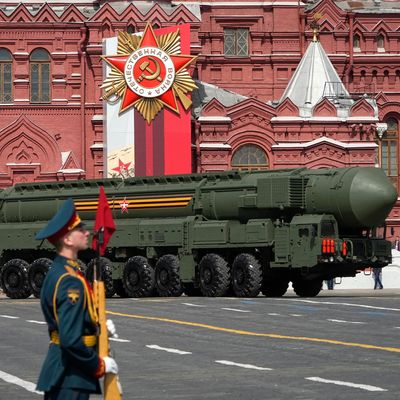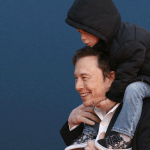
Suddenly, talk of nuclear apocalypse is in the air for the first time in decades. With his forces continuing to struggle in Ukraine, Russian president Vladimir Putin has begun regularly invoking his country’s massive arsenal of nukes in what many view as a sign of desperation. In a menacing speech last week, Putin claimed that he would use “all the forces and means at our disposal” to defend areas of Ukraine he had illegally annexed and that he was not bluffing. Though experts largely believe the chances are low that Putin will follow through on that threat, the mere possibility has rattled western leaders. I spoke with Edward Geist, a policy researcher at the RAND Corporation, about why a Russian nuclear strike could cause even more damage than intended, whether Putin’s strike orders could be ignored, and how the U.S. might respond.
Speaking about Vladimir Putin’s nuclear threats, President Biden said at a private fundraiser on Thursday night, “We have not faced the prospect of Armageddon since Kennedy and the Cuban Missile Crisis.” Do you think that was an appropriate comparison?
We don’t know what the probability of nuclear war is at any particular moment. We have intuitions, and the usual intuition is that the Cuban Missile Crisis is the closest we’ve ever come. But we actually don’t know how close we came then or at any other point in the past. There’s this controversy about the 1983 Able Archer exercise (a NATO exercise Russia mistook for military escalation) — whether that was actually a war scare. And I know experts on this subject who are diametrically opposed to one another on that question.
The thing that makes it so scary is that we genuinely don’t know. It’s not like there’s some magical dial in a cabinet at the Kremlin and Putin is twisting it up and down. The nuclear threshold doesn’t work like that. We don’t know quite how the different actions we take interact with that cosmic danger.
So you can’t say if we’re all going to die in the next week.
Despite all the reversals the Russians are having, they’re probably not on the verge of doing anything like this.
Other than Putin’s saber-rattling, is there any physical, tactical sign that anything is different about Russia’s nuclear posture than it was a month ago?
The U.S. intelligence community has said, and this is apparent to us, that the steps we would expect to see them take if they were about to use one of their so-called nonstrategic nuclear weapons (also known as tactical nuclear weapons) — we don’t seem to be seeing those indicators. Only a part of their strategic nuclear forces is actually sitting on missiles and ready to be used at any particular time. They have missiles in silos, and they have some missiles on submarines. Some of those things are always ready to fire, but the nonstrategic nuclear weapons are stored in central facilities separate from their delivery system. The missiles that would launch them — like the Iskanders or whatever — they don’t usually have nuclear weapons on them. In order to combine the two, you’d have to move things around. You’d have to take the launch system and the warhead to the same place, and we haven’t seen that activity.
It is true that the Russians could conceivably use a weapon off of one of these strategic platforms that’s always available. So the idea that we would get a warning before some kind of Russian limited nuclear use is something we can’t necessarily count on. Another thing that’s worrisome going forward is that they may just start doing some of this stuff as an intimidation tactic. They could take a nuclear warhead and put it on a nonstrategic launch platform and may just leave things that way, then not actually use any nukes.
Let’s say Putin did use a low-grade tactical nuke, whether that’s on a Ukrainian facility or as a show of force above a body of water. What would the immediate effect look like?
There’s this widespread notion that the first thing you might do is take one of these tactical nukes and detonate it over the ocean or something in order to demonstrate resolve. That’s very easy to do, and given Putin’s terrible judgment so far, I suppose we shouldn’t rule it out entirely. But it would actually leave a very different impression than people imagine, because it would look like nothing.
It’s not going to look intimidating; it’s actually going to look sort of dumb. If it’s not close to the surface, you’re not going to be able to see it. If there aren’t people nearby, you’re not going to have video of it. If you want to be intimidating, it has to be designed to look impressive on TV.
So let’s say he did something more dramatic and actually used it on facilities or people.
It depends on the combination of weapon and target and also some intangibles. There are people who assume there’s this Goldilocks point, where, if the weapon is accurate enough, you can maximize blast effects and avoid fallout effects by detonating it at a certain elevation over the target. In real life, it’s more complicated than that. In real delivery systems, the CEP (the circular error probable) — or the spherical error probable if you’re talking in three dimensions — that’s just for the weapons that don’t malfunction. Some of those possible malfunctions involve the weapon detonating in a place that’s outside the statistical distribution of what we consider a near miss.
Let me make this concrete. Let’s say Putin wants to nuke a command post in Ukraine somewhere. And Russia takes an Iskander ballistic missile and puts a tactical nuclear warhead on it. There are various claims for what size warhead might go on this thing, but let’s say it’s on the order of a few kilotons. They do the math to detonate this at a precise altitude, so that they’ll get the blast effect over the facility but avoid fallout. But then the weapon may malfunction. Maybe the fusing doesn’t work, so it donates at the wrong altitude. So the fireball does intersect with the ground, and there’s all this fallout. And they were trying to avoid that — but we didn’t know.
You had a Twitter thread about rain making nuclear fallout worse by contaminating the ground.
Yeah. So if you detonate a nuclear weapon and there’s a rain cloud above where all the radiological mess is in the ground, what would’ve been fallout is now “rainout.” And there are arguments I find convincing — this appears in computer models and appears to have maybe happened in the atomic bombings in Japan — where the nuclear explosion itself creates what’s called a pyrocumulus like a big forest fire can. The heat source actually causes a rain cloud to form, then it can rain out the nuclear fission products directly. That’s really scary, because it’s so near to the burst time that the stuff is ludicrously radioactive.
If it’s rained out within a few minutes of the burst, the doses that can be experienced on the ground by people are outrageous even for a low-yield device. So there are all these sorts of intangibles, where Russia could be trying very hard to engineer the attack to avoid collateral damage, then just fail.
If Putin wanted to launch nukes, is there a possibility that someone under him could successfully resist the order?
Supposedly, their system has a two-man rule. The Russian president is the National Command Authority, and he could order the use of nuclear weapons. But the Russian president, the minister of defense, and the head of the general staff all have the nuclear football. So it’s unclear what happens if Putin just loses his mind and says, “I hate America so much, I want to nuke America.” If Gerasimov and Shoigu are like, “Sir, you’ve gone mad, and I’m not going to agree to this” — what happens at that point? Because on the one hand, it has sometimes been asserted that at least two of those footballs have to be activated in order to actually use nuclear weapons. But Putin is allowed to dismiss those guys at will and find somebody who’s more compliant.
Like Nixon’s Saturday Night Massacre but much worse.
It’s not clear whether that mechanism actually would stop nuclear use of whatever kind from being authorized. But it’s not automated the way that people sometimes assert it is. There are a whole bunch of steps you have to go through. Like, if you’re on a submarine, the submarine has to come up to launch depth.
Pavel Podvig (an independent nuclear analyst) argues, and I am inclined to agree, that the fully automated system that was proposed in Russia in the 1980s never got implemented because of the obvious safety problems. With the systems as they are now, I believe there has to be a final guy with the key. And a lot of these systems — like the submarines, the mobile missile launchers — you have to take a lot of steps to get them ready to fire.
The Russian submarines can launch from dock sites. And with the mobile missile launchers, they’ve got special garages where the roof opens, so they can just sit in their garage and if they get the order, they can fire from the garage. But there’s still a series of steps you have to take.
Well, that’s mildly comforting. How do you rate the difference in odds between Russia using tactical nukes and the even more powerful ones?
It’s another one of these things that’s hard to know. But if Putin decided to do a demonstration strike, he could take one of their highest-yield weapons and detonate it over their old nuclear test site in the Arctic. And I think that would look a lot more impressive than detonating a low-yield weapon over the Black Sea. So the possibility should be considered more than it currently is.
Limited nuclear use is not the same thing as tactical nuclear use. The Russians have a whole lot of tactical nuclear weapons, and in principle, they could use a whole lot of them. And many of these nonstrategic weapons are not actually low-yield in a meaningful sense. A lot of them are on the same order as Hiroshima.
And we’re talking thousands, or tens of thousands, of these nukes?
By the estimates of the Federation of American Scientists, it’s maybe a couple of thousand, which by the standards of contemporary nuclear arsenals is a lot of weapons. By Cold War standards, that’s not actually that many, but the Cold War was crazy and frightening.
This week, President Zelenskyy of Ukraine issued a plea for “preemptive strikes” to prevent Russia from using nuclear weapons. (Ukraine claimed he was referring to economic sanctions.) I take it you don’t think a first-strike attack on Russian weaponry is likely.
Let’s just say that I find that sort of viewpoint fanciful, partly because the Russian policy is “launch under attack.” Going back to the Soviet era, if there’s a major attack against Russia from whomever, their policy is to try and launch their weapons while they are being attacked.
How do you think the U.S. or NATO would respond to Russia’s usage of low-grade nuclear weapons?
Western leaders would have to make a call about how they wanted to respond, and they may do something different than they imagined that they would do before it happened. It’s another one of these huge intangibles.
There has been debate in recent administrations about limited Russian nuclear use and how we should respond — Fred Kaplan talks about this in his book. There’s a school of thought that if they do it, we have to show that we are not intimidated, and the way we need to show that is by using one ourselves. There’s also a school of thought that we don’t solve this problem of somebody using nuclear weapons by using nuclear weapons ourselves. Which one of those is right depends on the perceptions of other people. It depends on the perceptions of the adversary, and it depends on the perceptions of audiences both at home and abroad.
There’s the argument that we have to say that we’re going to do that for deterrence, that we have to be ready to respond in kind or they will think that they can get away with doing it. But that’s not at all the same thing as saying that we actually should respond in kind in any particular situation — and especially not as a blanket policy.
This interview has been edited for length and clarity.
More From This Series
- The Reporter Behind the Trump Hush-Money Trial
- What on Earth Is Aileen Cannon Doing?
- Why an Ex-MLB Interpreter Thinks Ohtani Is Telling the Truth






























